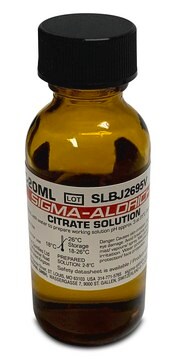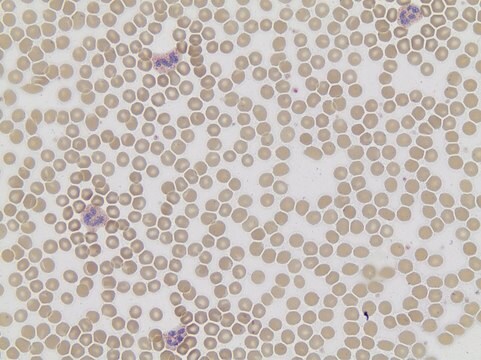85L1
Leukocyte Alkaline Phosphatase Kit
based on naphthol AS-MX phosphate and fast blue RR salt
Sign Into View Organizational & Contract Pricing
All Photos(2)
About This Item
UNSPSC Code:
12352106
NACRES:
NA.47
Recommended Products
Quality Level
shelf life
Expiry date on the label.
IVD
for in vitro diagnostic use
application(s)
hematology
histology
shipped in
wet ice
storage temp.
2-8°C
Looking for similar products? Visit Product Comparison Guide
Related Categories
Application
Leukocyte Alkaline Phosphatase (LAP) kits are intended for the qualitative demonstration of alkaline phosphatase activity in white blood cells.
Peripheral blood or bone marrow preparations are fixed to a microscope slide. The film is then incubated in a mixture of naphthol AS-MX phosphate alkaline solution with fast blue RR salt. The resulting blue, insoluble, granular dye deposit indicates sites of alkaline phosphatase activity.
Signal Word
Warning
Hazard Statements
Precautionary Statements
Hazard Classifications
Met. Corr. 1
Storage Class Code
8A - Combustible corrosive hazardous materials
Flash Point(F)
Not applicable
Flash Point(C)
Not applicable
Certificates of Analysis (COA)
Search for Certificates of Analysis (COA) by entering the products Lot/Batch Number. Lot and Batch Numbers can be found on a product’s label following the words ‘Lot’ or ‘Batch’.
Already Own This Product?
Find documentation for the products that you have recently purchased in the Document Library.
Customers Also Viewed
Alban J Smith et al.
Scientific reports, 7, 41872-41872 (2017-02-06)
The ability to isolate specific, viable cell populations from mixed ensembles with minimal manipulation and within intra-operative time would provide significant advantages for autologous, cell-based therapies in regenerative medicine. Current cell-enrichment technologies are either slow, lack specificity and/or require labelling.
Lee W Tien et al.
Macromolecular bioscience, 12(12), 1671-1679 (2012-10-17)
The alignment and osteogenic differentiation of MSCs on patterned silk films (PF) is investigated as a bottom-up approach toward engineering bone lamellae. Screening PF with various groove dimensions shows that cell alignment is mediated by both the pattern width and
Shigeki Ohta et al.
PloS one, 6(1), e16182-e16182 (2011-01-21)
Epidermal melanocytes play an important role in protecting the skin from UV rays, and their functional impairment results in pigment disorders. Additionally, melanomas are considered to arise from mutations that accumulate in melanocyte stem cells. The mechanisms underlying melanocyte differentiation
Jonathan Ferrand et al.
PloS one, 6(12), e29007-e29007 (2012-01-05)
The role of bone marrow-derived mesenchymal stem cells (MSC) in the physiology of the gastrointestinal tract epithelium is currently not well established. These cells can be recruited in response to inflammation due to epithelial damage, home, and participate in tissue
Masaharu Hiratsuka et al.
PloS one, 6(10), e25961-e25961 (2011-10-15)
Human artificial chromosomes (HACs) have unique characteristics as gene-delivery vectors, including episomal transmission and transfer of multiple, large transgenes. Here, we demonstrate the advantages of HAC vectors for reprogramming mouse embryonic fibroblasts (MEFs) into induced pluripotent stem (iPS) cells. Two
Our team of scientists has experience in all areas of research including Life Science, Material Science, Chemical Synthesis, Chromatography, Analytical and many others.
Contact Technical Service

